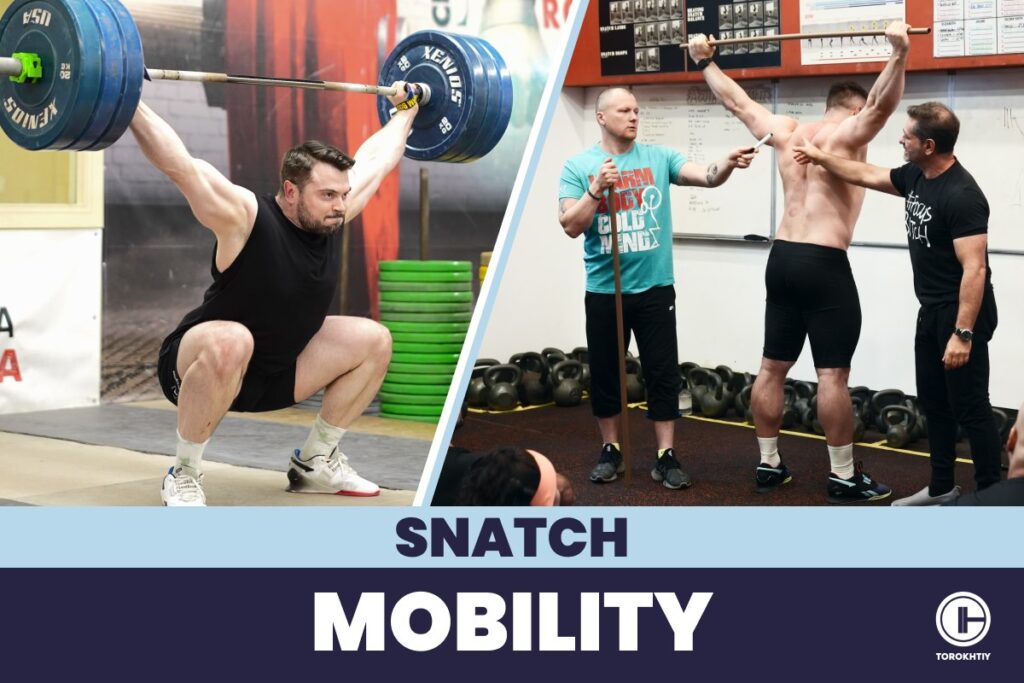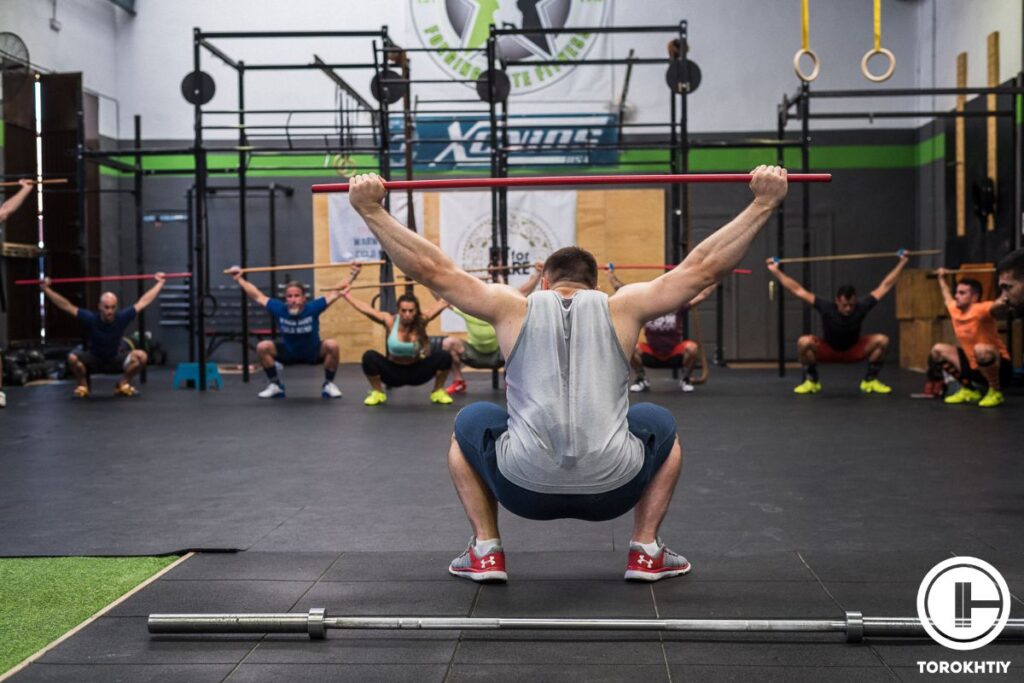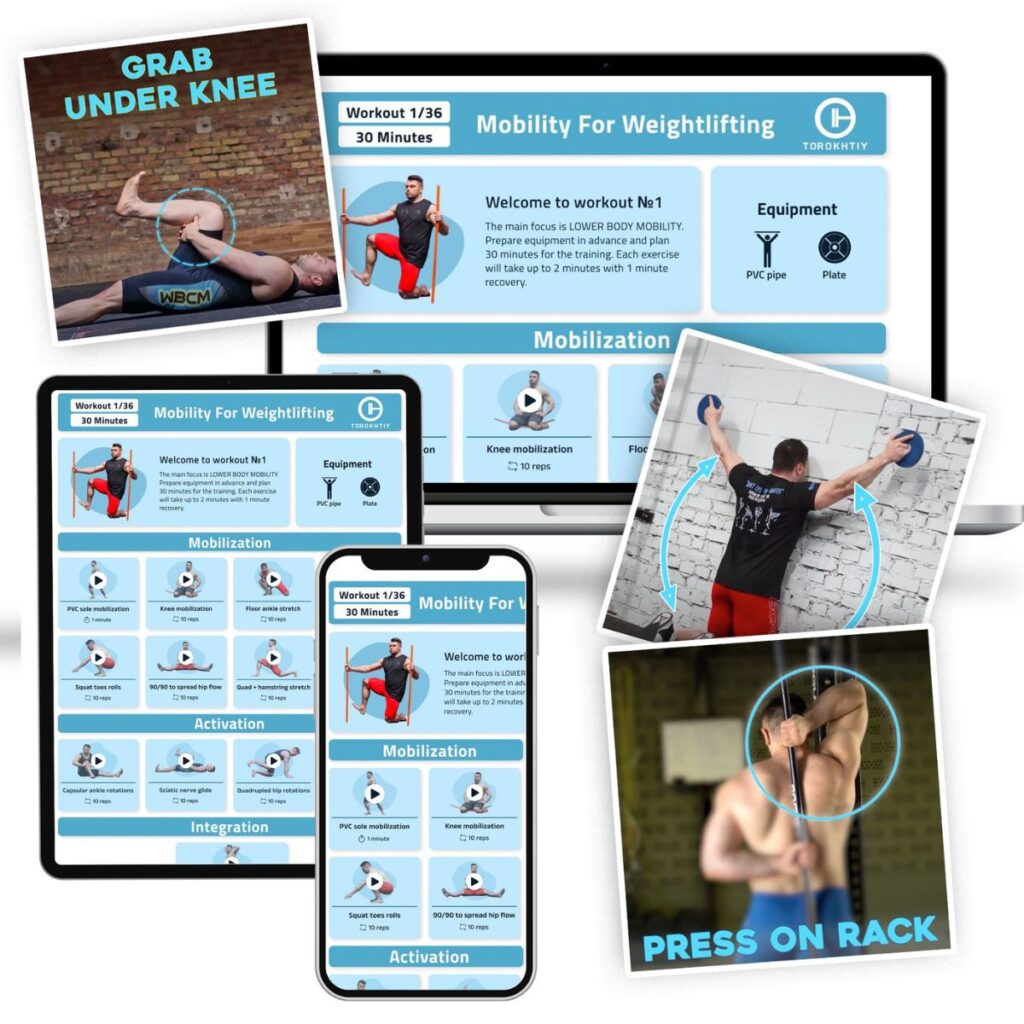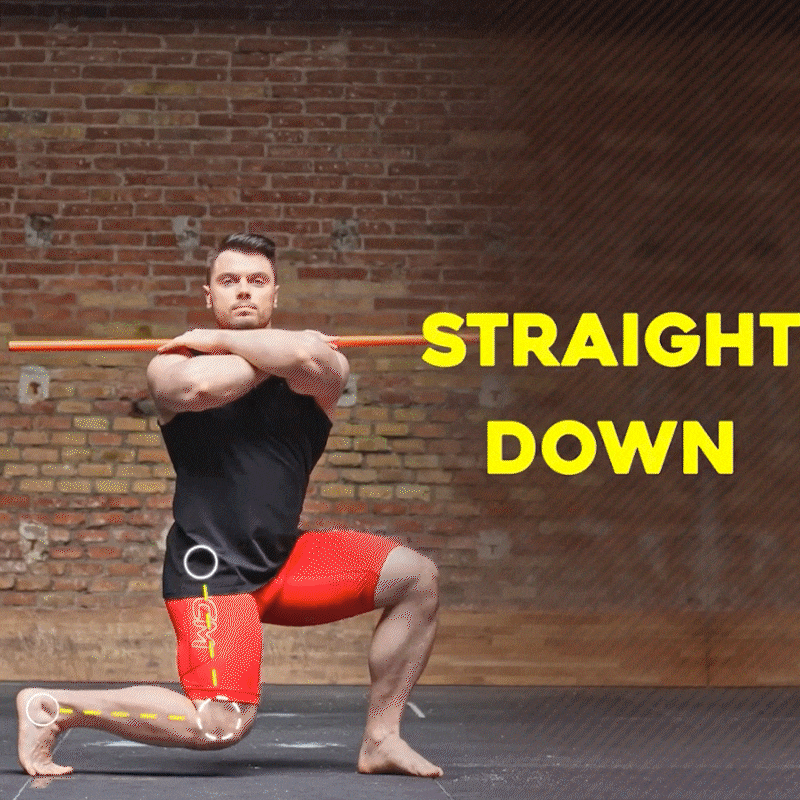Snatch Mobility: Check the Most Effective Drills
Author:
Reviewed by:
(21 years of Oly Lifting experience)
Unlock your full potential by engaging with our experts and community! Have questions about your fitness journey or looking for expert advice on weightlifting techniques? Don’t hesitate — leave a comment below and Sergii Putsov will provide a personalized answer and insights to help you reach your goals.
Torokhtiy is reader-supported. Some links are affiliate links, and we may earn a commission at no extra cost to you. See our disclosure page for details.
Weightlifting requires a high level of mobility. A decent amount of muscular flexibility and joint mobility are also necessary for a stable and safe snatch execution, in addition to a high level of strength and coordination. Poor mobility will limit progress if weightlifters are unable to move in particular ways.
The Olympic snatch is a total body movement that requires superb technique, mental resilience, and physical power. You will benefit from working to increase your snatch mobility both for the lift itself and for other aspects of Olympic weightlifting training.

Why Is Mobility Important For Snatch?
As you are undoubtedly aware, snatch makes the majority of an athlete’s mobility problems obvious. The snatch’s receiving stance places tremendous demands on both flexibility and stability. So, you definitely need to increase your mobility if you want to get better in Olympic snatch!
You will benefit from working to increase your snatch mobility in both the lift itself and other aspects of your training.
This will help to:
- avoid injuries;
- strengthen movement skills;
- increase ROM of various exercises;
- improve performance;
- enhance overall health.
You should be able to move your body efficiently to do the snatch since it involves so many different muscles, from your feet to your shoulders.
To learn how to snatch you can take a look on my Snatch MasterClass – LINK
Having enormous military press or deadlift strength is useless if you are unable to maintain the bar during a catch in overhead position, for example, because you are too immobile. You will be unable to do snatch variations to your full ability without the required mobility.
Mobility is not the goal to itself – it creates Opportunities!
Can directly translate to higher power output and improved performance. Better positions translate to higher Power Output, Movement Efficiency translates to improved Endurance.
How To Improve Your Snatch Mobility?
People who struggle with overhead squats frequently keep trying in the hopes that one day they will become better. The majority of the time, they make a small improvement, like one would while learning a new action, only to suffer from injuries and bad mechanics that quickly resurface in more difficult moves like snatches.
Mobility is more important than you may think because lack of it limits your range of motion, and even outside of Olympic Weightlifting, training with a partial range of motion is a lot less effective than the opposite.
A systematic method that considers the essential joint motions, flexibility, and stability across each joint that composes the entire is important to address the mobility concerns for the overhead squat.
If you want to improve snatch mobility, you should address:
- soft tissue limitations,
- joint limitations,
- and motor control.
For soft tissue limitations, use techniques like rolling and flossing to handle restrictions in muscles and fascia. For joint limitations, do mobility exercises to increase the range of motion in your joints. And when it comes to motor control, include stability exercises to improve motor control and maintain proper positioning during the snatch.

It’s always good to mobilize in the position of restriction and combine soft tissue work above and below the targeted point.
So how to stretch out snatch?
Let’s take a look on the most effective exercises for the overhead mobility in snatch:
1. Prayer Stretch
Purpose: triceps, upper back and lat stretch.
Initial Position: bend your arm at the elbow, place the triceps on the support.
How to Perform:
Your shoulders should be as low as they can go. To focus on thoracic spine mobility, be cautious to extend your upper back as you perform this exercise. Because this will become a lat stretch if you retain a slight arch in your back. By adapting the method of this mobility exercise to the regions where you are tight, you may make the most of your time.
Load: feel free to use this exercise during warmup or post workout stretching, hold this position for 20-40 sec
2. Deep Chest Opener
Purpose: chest muscles stretching and shoulder mobilization.
Initial Position: take a quadrangle initial position, place wrist under the shoulder, knee under the hip joint and keep your spine straight. Place one hand behind your head.
How to Perform:
Inhale and move your elbow aside & up, open chest, push with another arm against the floor. Exhale and move your arm under the supporting arm.
Load: feel free to use this exercise during warmup or post workout stretching. Perform 8-12 reps for each side up to 3 sets.
3. Rubber Band Spins
Purpose: upper body mobilization and muscles warmup.
Initial Position: step on the rubber band with both feet and grab the rubber band with both hands.
How to Perform:
Move your hands over the top back and forth with a comfortable tempo.
Load: feel free to use this exercise during warmup. Repeat for 10-12 reps up to 3 sets.
4. PVC Shoulders Circle Ups
Purpose: upper body mobilization and muscles warmup.
Initial Position: take a PVC with a comfortable wide grip.
How to Perform:
Move PVC back and forth in a circle through one side.
Load: feel free to use this exercise during warmup. Perform for 10-12 reps up to 3 sets.
5. PVC Raise
Purpose: upper back mobilization.
Initial Position: laying on stomach, middle grip, core tight.
How to Perform:
Hold your arms straight above the floor. Raise PVC up and squeeze shoulder blades. Work at a comfortable tempo.
Load: feel free to use this exercise during warmup or post workout. Repeat for 15-20 reps up to 3 sets.
6. Snatch Sots Press
The drill was developed by Soviet world champion Viktor Sots & his trainer Pyotr Alaev. They never imagined this exercise would be one of the most well-known workouts when they created it more than 40 years ago. In actuality, it’s a deep squat press behind the neck with a snatch grip.
There are both power and technical versions. But in both situations, the same objective is sought to strengthen and enhance shoulder joint mobility as well as to improve the squat posture. All levels of athletes should incorporate this exercise into their training routine.
Follow us!

Free!
Get a 2-week Weightlifting Program as a bonus for the subscription to kickstart your training plan!

Free!
Purpose: specific overhead snatch mobility development.
Initial Position: snatch catch position.
How to Perform:
Press the bar/pvc from behind the neck to overhead position and hold it for 3 seconds. Avoid jerking movements, try to engage all upper body muscles and focus on deep and stable squat position.
Load: most athletes perform this exercise with an empty bar or light weight 6-10 reps 3-5 sets.
7. PVC Duck Walk
Purpose: integral body preparation for snatch exercises. In addition to warming up most of lower-body musculature, the duck walk also engages the core musculature.
Initial Position: place feet with a hip-width. While maintaining your feet level on the ground, bend knees, push glutes back and drop your hips until thighs are parallel to the ground or as deep as you can sit comfortably. Maintain a high chest while raising your arms above in a snatch grip.
How to Perform:
Step forward with the left foot first, then the right, keeping your body in a squat snatch overhead position or as deep as you can go. As you walk, make sure to maintain balance on your mid foot. Continue to advance in this way for the required amount of steps.
Load: most athletes perform this exercise with PVC for 8-12 reps 3-5 sets.
FAQ
How Do You Open Shoulders For Snatch?
To prepare shoulders for snatching you must plant specific warm up before snatching. It can consist of 2-3 exercises with a rubber band or PVC to engage the upper body in all planes. You can perform these exercises in circle mode for 2-3 rounds to increase its efficiency.
How Do You Warm Up For A Snatch?
If you’ve ever snatched, you’re aware that having movement issues may seriously affect how well and safely you can prepare for the Olympic snatch. In order to properly warm up before a snatch workout, the hips, shoulders and thoracic spine must be mobilized and activated through stretching as well as careful rotation of each joint to enhance range of motion.
🔻Test Your Mobility Before Starting the Program
Mobility is crucial because it directly impacts your performance, technique, and overall safety.
Complete 3 simple tests to evaluate your current mobility.
Our Program Includes:
- 📺 80 Videos for every exercise:
Unique movements, supported by detailed graphics and voice-over. - 📆 36 Workouts x 30 minutes each:
12-weeks plan can be used as standalone program or as a pre-/post-workout training. - 📊 Tests to track you progress:
Make simple tests in the beginning and after finish to elevate your result. - 🏋️♂️ Made by Olympian:
Designed by a Champion, under the guidance of PhD in sport science and physiotherapist. - 💲One-time payment:
No monthly or any other recurring payments. One payment, life-time usage.
Conclusion
Definitely, mobility is a crucial component of Olympic weightlifting, especially in snatch. Poor mobility will limit progress if weightlifters are unable to move in certain ways.
All athletes will benefit from working to increase snatch mobility in both the lift itself and for other aspects of training because mobility exercises have an all-around positive influence. What’s your favorite snatch mobility drill? Do you think I left anything out? Let’s discuss it in the comments!
References:
- Brad J. Schoenfeld, Jozo Grgic, Douglas W. Van Every, Daniel L. Plotkin “Effects of range of motion on resistance training adaptations: A systematic review and meta-analysis,” Sports Medicine. 2021 Oct; 51(9): 1991-2007.
- Robert Schleip, Carla Stecco, Werner Klingler, Andreas Zorn, David G. Mueller, Martin W. Hoppe, Elisa F. Casari, Eric Hohenauer “The Influence of Mobility Training on the Myofascial Structures of the Back and Extremities,” Journal of Clinical Medicine 2023 Jan; 13(2): 329.
- Photos are made by Torokhtiy Media team.
Also read:
Why Trust Us?
With over 20 years in Olympic weightlifting, strength training, nutrition coaching, and general fitness our team does its best to provide the audience with ultimate support and meet the needs and requirements of advanced athletes and professional lifters, as well as people who strive to open new opportunities and develop their physical capabilities with us.
By trusting the recommendations of our certified experts in coaching, nutrition, and sports training programming, as well as scientific consultants, and physiotherapists, we provide you with thorough, well-considered, and scientifically proven content. All the information given in the articles concerning workout programming, separate exercises, and athletic performance, in general, is based on verified data.
The product testing process is described in more detail here.
Author: Sergii Putsov
Head of Sport Science, PhD
Best Results: Snatch – 165 kg,
C&J – 200 kg
Sergii Putsov, Ph.D., is a former professional weightlifter and National team member, achieving multiple medals in the 94 kg weight category at national competitions. With a Master’s degree in “Olympic & Professional Sport Training” and a Sport Science Ph.D. from the International Olympic Academy, Greece, Sergii now leads as the Head of Sport Science. He specializes in designing training programs, writing insightful blog articles, providing live commentary at international weightlifting events, and conducting educational seminars worldwide alongside Olympic weightlifting expert Oleksiy Torokhtiy.
Reviewed by: Oleksiy Torokhtiy
Olympic Weightlifting Champion, PhD in Sport Science
Best Results: Snatch – 200 kg,
C&J – 240 kg
Oleksiy Torokhtiy is a professional athlete boasting 20 years of experience in Olympic weightlifting. With multiple European and World titles under his belt, he has showcased his prowess in two Olympic Games (Beijing 2008 and London 2012). Upon concluding his illustrious career, Oleksiy dedicated himself to coaching. By 2022, he had conducted over 200 weightlifting seminars worldwide. He is the visionary behind an international sportswear and accessories brand known for its motto, “Warm Body Cold Mind.” Additionally, he is an esteemed author and the creator of a series of training programs and eBooks.






Still have questions after reading our article? Unlock your full potential by engaging with our experts and community! Don’t hesitate — leave a comment below and Sergii Putsov will provide a personalized answer and insights to help you reach your goals.